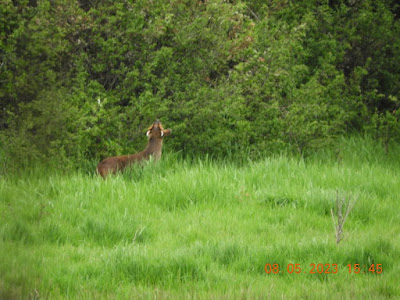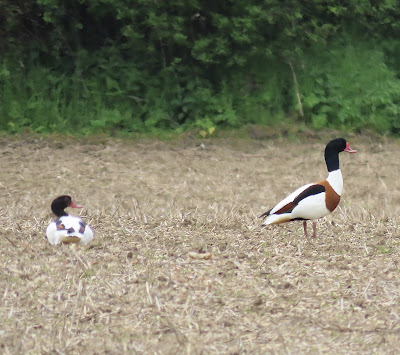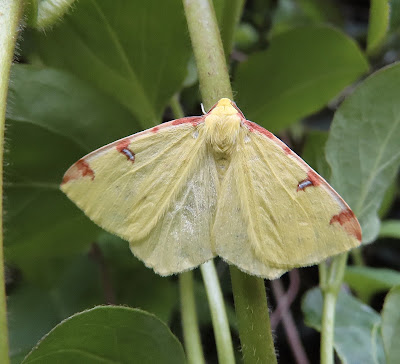Birds seen at the park by Caroline were whimbrel, yellow wagtail, sedge warbler and common tern, as well as a painted lady butterfly.
Andy Field walked the Cudmore circuit on Monday morning and reported five lesser whitethroats, ten whitethroats, six blackcaps, eight reed warblers, possible willow warbler, four chiffchaff, lapwing pair in the fields with two chicks, seven pochard on the pond, three Cetti's warblers and two common terns off the Point. Butterflies noted included brimstone, speckled wood and orange-tip.
Two shelduck were seen resting in a field beside the East Mersea footpath from Shop Lane to Meeting Lane on Monday. The nightingale was singing loudly at the north end of Shop Lane and there was lots of calling of hooetting and croaking notes which might suggest a second bird was involved.
A willow warbler was singing from birch trees to the west of Shop Lane, this bird now present here for four days. Three Cetti's warblers, three lesser whitethroats, five whitethroats, yellowhammer, three linnets, buzzard and ten swallows were noted in the area.
Half a dozen latticed heath moths were seen on the wing during the walk, which seemed more than usual.
Several painted lady butterflies were seen on Sunday 7th during a walk along the north side of the Island with one at the Oyster Fishery, two at Reeveshall both continuing north off the island, one at Maydays and another along the Strood seawall. This spread of individuals must be due to a small influx from the continent, although there don't appear to many other reported sightings of them elsewhere.
A brimstone was seen at Reeveshall and also at Maydays where an orange-tip was also on the wing.
Lots of whimbrel seen along the back of the island on Sunday with four near Ivy Farm, twelve along the Pyefleet and another twelve in the Strood channel. Other waders seen were two ringed plovers on mud at Cudmore Grove, two lapwings on the fields there, pair of avocet on the Reeveshall pool, eighteen black-tailed godwits on Reeveshall and nine avocets in the Strood.
Nine greylag geese and a pochard were at Cudmore Grove, two Canada geese and five greylag geese in the Pyefleet, cuckoo flying at Reeveshall, also seen from there were four Mediterranean gulls, four marsh harriers, two buzzards and a pair of gadwall. Two hobbies were hawking after insects over the Langenhoe ranges - one of the hobbies hawking over the Reeveshall seawall briefly.
Several pairs of common terns were seen along the north side of the island on Sunday with 3 in the Colne, six along the Pyefleet and three in the Strood channel.
Four brown hares were running about the field beside the Strood reservoirs on Sunday afternoon, two were also seen on Bower Hall, while at Reeveshall a Chinese Water Deer was seen grazing one of the grass fields for the second day running.
A corn bunting was singing from a bush by the Strood seawall on Sunday, earlier six had been seen flying off the Bower Hall saltmarsh.
Three pairs of red-legged partridges were seen in the fields either side of the Strood Hill on Sunday, also thirty stock doves were feeding, while a dozen swifts flew over West Mersea.
At Cudmore Grove the barn owl was seen by Shaun Bater flying from the grazing field and went straight into the nestbox by the pond without reappearing on Sunday.
At West Mersea nine swifts were seen by Andy Field flying over Upland Road on Sunday.
On Saturday 6th birds seen at Maydays included a cuckoo calling from Maydays and another one calling from Langenhoe. A short-eared owl was hunting along the Langenhoe seawall, while three marsh harriers and a buzzard were seen. Also two Canada geese flew over, as did a gadwall, along the Pyefleet were six whimbrel, eight grey plover, two great crested grebes and an avocet.
A Cetti's warbler was singing near the Maydays seawall and another at the top of Haycocks Lane on Saturday, two sedge warblers, two reed warblers, lesser whitethroat, two whitethroats and a yellowhammer were also at Maydays.
Two swifts were heard squealing high over Andy Field's garden in High Street North on Saturday.
At Cudmore Grove on Saturday Caroline White reported two shelduck, Cetti's warbler, five reed buntings, two reed warblers, three whitethroats, two lapwing chicks with an adult, four greylag geese, two pairs of tufted ducks, greenshank in the grazing field, mute swan pair, two greylag geese, three pochard, two linnets, five blackcaps towards hide and another pair there, three chiffchaffs, sparrowhawk and two little grebes on the pond.
On Friday 5th at Maydays, Martin Cock saw a probable ringtail hen harrier seen briefly which was also seen at East Mersea by Andy Field but too distant to confirm an ID. Also at Maydays were a cuckoo, Canada goose, four whimbrel, three Cetti's warblers, sedge warbler and reed warblers. A Chinese water deer was flushed from the dyke at Maydays and then ran across the fields.
At Cudmore Grove on Friday morning Andy Field saw the usual whitethroats and lesser whitethroats, two lapwing chicks on the grazing field, greenshank still on one of the fields, cuckoo calling distantly to the west of the park, 50 ringed plovers and 84 dunlin.
Caroline Wilson visited Cudmore Grove on Friday evening and reported a great spotted woodpecker on the Golfhouse path, three whitethroats and one lesser whitethroat beside the fields and dyke, two lapwings, mute swan pair, nine greylag geese, six shelduck, 3 pochard, tufted duck pair, sparrowhawk, kestrel, reed bunting along the dyke. At the pond the barn owl perched on a post for quarter of an hour before flying off to the grazing fields. A whitethroat and a pair of blackcaps were near the hide.
Steve Entwistle on Friday reported two red-legged partridge near the East Mersea Road below Island House, also three swifts, swallow and cuckoo flying over his house in Empress Drive.
On Thursday 4th fifteen brent geese were still in the Mersea Quarters near Cobmarsh Island, while along the Strood seawall were seen two whimbrel, three turnstones, great crested grebe, marsh harrier, buzzard, two swifts, house martin, red-legged partridge, two yellow wagtails and a corn bunting.
At Maydays farm on Thursday Martin Cock reported a peregrine, male marsh harrier, greenshank, whimbrel, sedge warbler, reed warbler, Cetti's warbler, whitethroat and a blackcap.
A red kite circled high over the Firs Chase garden which upset the local carrion crow pair on Wednesday 3rd.
A male marsh harrier was quartering over the Strood fields on Wednesday, four buzzards, sparrowhawk and two kestrels also noted. Two grey herons flew over to the small pond at the back, while in the fields were ten shelduck, male shoveler, pair of gadwall, pair of red-legged partridge, 22 stock doves, fifty carrion crows and three yellow wagtails. Three whimbrel and four common terns were along the Strood channel and a swift flew over the houses.
Between Shop Lane and Meeting Lane on Wednesday Martin Cock reported the nightingale still singing in Shop Lane, willow warbler singing, four lesser whitethroats, five whitethroats, four blackcaps, Cetti's warbler and three chiffchaffs.
Four brimstone moths in the trap on the night of Sunday 7th added a bit of colour to the proceedings.
The migrant silver Y moth was also in the trap on Sunday evening, as was a yellow-barred brindle, shuttle-shaped dart and a double-striped pug.
A large cockchafer was resting on the outside of the moth trap. Several usually turn up at the trap during the spring.




















No comments:
Post a Comment